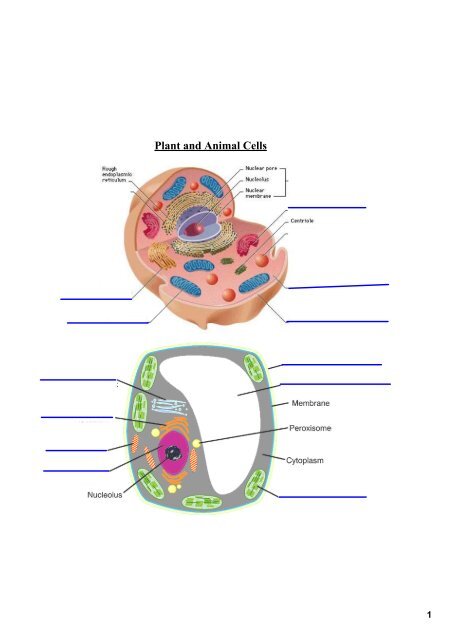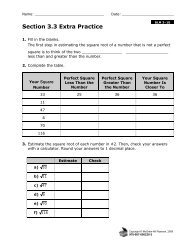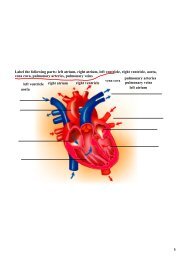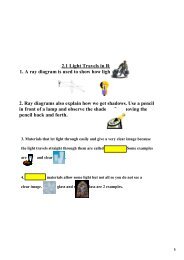cell labelling.pdf
cell labelling.pdf
cell labelling.pdf
Create successful ePaper yourself
Turn your PDF publications into a flip-book with our unique Google optimized e-Paper software.
Plant and Animal Cells<br />
1
Chapter 4: Cell Structure and Function<br />
CHAPTER 4, CELL STRUCTURE AND FUNCTION QUIZ <br />
4.3 Eukaryotic Cells<br />
A. Eukaryotic Cells<br />
1. Include larger <strong>cell</strong>s of organisms (belonging to kingdoms Fungi, Animalia, Plantae and Protista)<br />
2. Membranebounded nucleus houses DNA in threadlike structures called chromatin.<br />
3. Similar to prokaryotic <strong>cell</strong>s, eukaryotic <strong>cell</strong>s have a plasma membrane and cytoplasm including ribosomes.<br />
4. Eukaryotic <strong>cell</strong>s are more complex than prokaryotic <strong>cell</strong>s, have organelles, including a true nucleus, and an<br />
organized lattice of protein filaments called the cytoskeleton.<br />
1. Structures<br />
a. Nucleus has a diameter of about 5 micrometers.<br />
b. Chromatin is a threadlike material that coils into chromosomes just before <strong>cell</strong> division occurs;<br />
contains DNA, protein, and some RNA.<br />
c. Chromosomes are rodlike structures formed during <strong>cell</strong> division; coiled or folded chromatin.<br />
d. Nucleoplasm is semifluid medium of nucleus; has a different pH from cytosol.<br />
e. Nucleoli are darkstaining spherical bodies in nucleus; sites where rRNA joins proteins to form ribosomes.<br />
f. Nuclear envelope is a double membrane that separates nucleoplasm from cytoplasm.<br />
g. Nuclear pores (100nm) permit passage of proteins into nucleus and ribosomal subunits.<br />
h. The nucleus is the site of DNA and determines characteristics of the <strong>cell</strong> by coding for proteins.<br />
D. Ribosomes Are Sites of Protein Synthesis<br />
2. Endoplasmic reticulum<br />
a. Endoplasmic Reticulum (ER) is system of membrane channels continuous with outer membrane<br />
of the nuclear envelope.<br />
b. Rough ER is studded with ribosomes on cytoplasm side; site where proteins are synthesized and<br />
enter the ER interior for processing and modification.<br />
c. Smooth ER is continuous with rough ER, but lacks ribosomes; site of various synthetic processes,<br />
detoxification, and storage; smooth ER forms transport vesicles.<br />
d. A combination of microscopy and biochemical analysis allows researchers to det<br />
2
3. Golgi Apparatus<br />
a. Golgi apparatus is named for Camilo Golgi who discovered it in 1898.<br />
b. Golgi apparatus consists of a stack of 320 slightly curved saccules.<br />
c. Golgi apparatus receives proteinfilled vesicles that bud from the ER.<br />
d. Vesicle fuses with membrane of Golgi apparatus or moves to outer face after proteins repackaged.<br />
e. Vesicles formed from membrane of outer face of the Golgi apparatus then move to different locations<br />
in <strong>cell</strong>; at plasma membrane, they discharge their contents as secretions.<br />
4. Lysosomes<br />
a. Lysosomes are membranebound vesicles produced by Golgi apparatus and contain digestive enzymes.<br />
b. Macromolecules enter a <strong>cell</strong> by vesicle formation; lysosomes fuse with vesicles and digest contents.<br />
c. White blood <strong>cell</strong>s that engulf bacteria use lysosomes to digest bacteria.<br />
5. Vacuoles<br />
a. A vacuole is a large membranous sac; vesicles are smaller than vacuoles.<br />
b. More prominent plant <strong>cell</strong> vacuoles (usually one or two) are water filled and give support to <strong>cell</strong>.<br />
c. Plant vacuoles store water, sugars, salts, pigments and toxic substances to protect plant from herbivores.<br />
d. Vacuoles in protozoa include digestive vacuoles and waterregulating contractile vacuoles.<br />
F. EnergyRelated Organelles<br />
1. Chloroplasts are membranous organelles that serve as sites of photosynthesis.<br />
a. Photosynthesis is the process by which solar energy is converted to the chemical energy of<br />
carbohydrates: light energy + carbon dioxide + water carbohydrate + oxygen.<br />
b. Only plants, algae, and cyanobacteria are capable of carrying on photosynthesis.<br />
c. Chloroplasts are about 46 micrometers in diameter and 15 micrometers in length.<br />
d. Chloroplasts are a type of organelle called a plastid; plastids include amyloplasts, which store<br />
starch, and chromoplasts, which contain red and orange pigments.<br />
e. Chloroplasts are bounded by a double membrane organized into flattened sacs (thylakoids) piled<br />
into stacks called grana with a fluidfilled space around thylakoids called the stroma.<br />
f. Chlorophyll is located within the thylakoid membranes.<br />
g. The stroma contains enzymes that catalyze reactions involved in synthesis of carbohydrates.<br />
2. Mitochondria are membranous organelles; sites of <strong>cell</strong>ular respiration.<br />
a. Cellular respiration is the process where chemical energy of carbohydrates is converted to that of ATP,<br />
the carrier of energy in <strong>cell</strong>s: carbohydrate + oxygen carbon dioxide + water + energy.<br />
3





